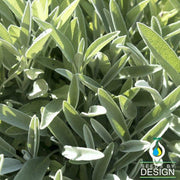DESCRIPTION
Broad Leaved Sage Herb Garden Seeds
Broad Leaved Sage Herb Growing Habits
Non-GMO (Salvia officinalis) Broad Leaved Sage grows as a warm perennial herb reaching 1-2" high as a flowering subshrub. This variety of sage blooms in late spring through mid-summer or once again in early fall. Once plants reach maturity, sage develops semi-woody stems and gray-green leaves"providing an earthy aroma with mild pepper and sweet flavor. Sage plants continue producing and spread similar to mint, as they fully establish during the second year. As the lower temperatures drop, cold-hardy sage varieties will go dormant overwinter, after blooming bold violet-indigo flowers and setting seed.
The Culinary Uses of Broad Leaved Sage Garden Herb & Seed
Broad Leaved Sage is a bold flowering herb that is known to provide culinary benefits to several savory dishes. From flavoring meat such as Italian sausage to be an essential ingredient in holiday stuffing, minty sage varieties offer mild pepper and sweet notes to dressings or pasta!
The Herbal Tea Benefits of Growing Broad Leaved Sage Garden Herb
As one of the most versatile flowering perennials, adding Broad Leaved Sage to your garden will not only be a decoration but a culinary offering. This sage variety is known as an ideal herbal tea due to its sweet and earthy taste! Although other types of sage taste more bitter, the gray-green foliage of this Broad Leaved Sage offers a more minty flavor. Sage has rich vitamins that boost your overall immune system and contain bold antioxidants that may help reduce cancerous cell growth.
ATTRIBUTES
Basic Info
| Latin Name: |
Salvia officinalis |
| Color: |
Semi-woody stem, gray-green leaves, violet-indigo flowers |
| Flavor: |
Bold, earthy, sweet, mint, mild pepper |
Growing Info
| Days to Maturity: |
70-80+ Perennial |
| Hardiness Zones: |
5-8 |
| Growth Habit: |
Upright/subshrub/spread |
| Soil Preference: |
Rich, sandy, loamy and well-drained |
| Temp Preference: |
Warm |
| Light Preference: |
Full sun |
Other
| Seed Planting Depth: |
1/4 Inches |
| Seed Plant Spacing: |
18-24 Inches |
| Pests/Diseases: |
Slugs, caterpillars, leaf spot |






